Lieutenant Melville C. Wilkinson requests to temporarily engage in "Indian educational work" in Oregon, and Acting Secretary of the Interior A. Bell forwards and endorses Wilkinson's request to the Commissioner of Indian Affairs and the Secretary of War. In his telegraph to the Secretary of War, Bell states that Wilkinson's work will be similar…
1870-1879
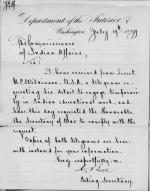
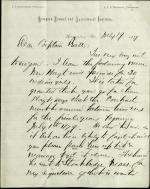
Samuel Chapman Armstrong of the Hampton Institute writes to Richard Henry Pratt informing him that Commissioner of Indian Affairs Hayt has promised a contract to recruit 20 Indian girls for the Hampton Institute. Armstrong discusses a desire to push Hayt for a larger contract for a higher recruitment number, and discusses logistics for Pratt's…
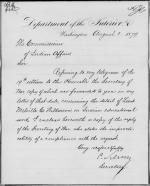
Secretary of War George W. McCrary informs Assistant Secretary of the Interior A. Bell that he does not have authority to allow Lieutenant Melville C. Wilkinson to engage in Indian education as Richard Henry Pratt is already in that line of work. Instead, Wilkinson will be sent to a college in Oregon where certain Indian youth can be sent.…
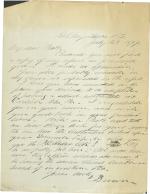
Brown writes to Richard Henry Pratt sending a report and congratulating him on getting permission to establish the Carlisle Indian Industrial School.
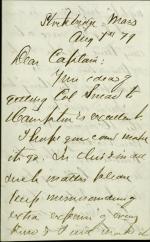
Samuel Chapman Armstrong of the Hampton Institute writes to Richard Henry Pratt discussing numerous topics include the per-capita rate for Indian students, a potential visit by Col. Snead, a competitive funding issue between Hampton and Howard University, and student progress.
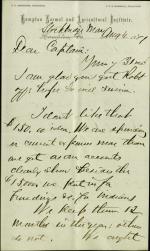
Samuel Chapman Armstrong of the Hampton Institute writes to Richard Henry Pratt discussing concerns over a proposal for too low of a per capita rate for Indian students.
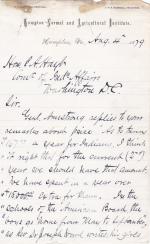
Letter from Richard Henry Pratt to Commissioner of Indian Affairs Ezra A. Hayt suggesting an increase in the per-student funding afforded by the government to Indian schools. Pratt also encourages the Commissioner to continue pursuing Congressional approval for the opening of an Indian school at the Carlisle Barracks.
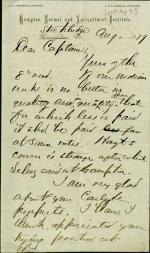
Samuel Chapman Armstrong of the Hampton Institute writes to Richard Henry Pratt about Pratt's attempts to establish a school at Carlisle. Armstrong notes that Commissioner of Indian Affairs Hayt seems less inclined to support their work. Armstrong also notes that he is glad to hear of Pratt's prospects with Carlisle, that he recognizes the "…
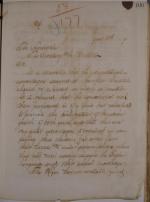
A letter wherein Commissioner of Indian Affairs Ezra A. Hayt writes to Secretary of the Interior Carl Schurz to recommend expanding the kind of educational program pursued at Hampton for "the civilization of Indian youth of both sexes… far away from their homes". Hayt requests that the Secretary of War approve the use of Carlisle Barracks in…
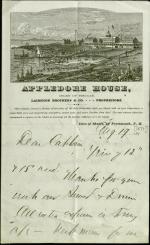
Samuel Chapman Armstrong of the Hampton Institute writes to Richard Henry Pratt discussing public sentiments towards Indian education, arguing that Pratt's upcoming school at Carlisle will help shift public views.
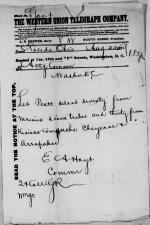
Commissioner of Indian Affairs E. A. Hayt instructs the Acting Commissioner to allow Richard Henry Pratt to select 70 students from Sioux Nations and 30 from the Kiowa, Comanche, Cheyenne, and Arapaho Nations.
Note: This item was copied from U.S. National Archives microfilm reels (M234), which were filmed from the original documents…
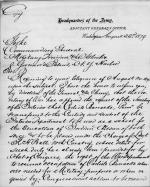
Adjutant General E. D. Townsend states that the Secretary of War has approved the Secretary of the Interior's request to transfer the Carlisle Barracks from the War Department to the Interior. The Barracks will be used as a school for Indian children and will be under the charge of Richard Henry Pratt. The War Department retains the right to…
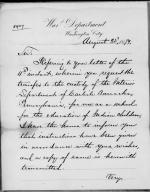
Secretary of War George W. McCrary informs the Secretary of the Interior that he has issued orders to transfer the Carlisle Barracks to the Interior Department to use as an Indian school.
Note: This item was copied from U.S. National Archives microfilm reels (M234), which were filmed from the original documents found in Record Group 75,…
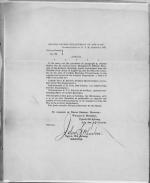
The Chief Clerk for the Secretary of War forwards a series of documents to the Secretary of the Interior regarding the transfer of the Carlisle Barracks from the War Department to the Interior Department. First, Adjutant General E. D. Townsend issues Special Orders No. 194 stating that Richard Henry Pratt now officially works in Indian…
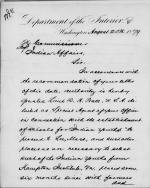
Acting Secretary of the Interior A. Bell informs the Commissioner of Indian Affairs that he is giving permission to Lieutenant Richard Henry Pratt to proceed to Lee, Massachusetts. Bell notes that Pratt will secure current Hampton Institute students who are on outing and take them to the Carlisle Barracks. These Hampton students will become…
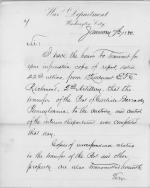
Secretary of War Alex Ramsey transmits to Secretary of the Interior Carl Schurz a report from Lieutenant E. T. C. Richmond indicating that the transfer of the Carlisle Barracks from the War Department to the Interior was completed on January 6, 1880 and correspondence regarding said transfer. Also attached is an official order from Major…
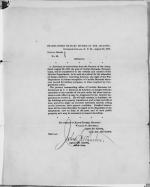
Captain William G. Mitchell issues Special Orders No. 52 ordering the transfer of the Carlisle Barracks from the War Department to the Interior Department, with the Barracks' commanding officer Lieutenant E. T. C. Richmond overseeing the transfer and taking inventory of the value of the transferred goods and buildings. Major General Winfield S…
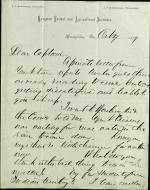
Samuel Chapman Armstrong of the Hampton Institute writes to Richard Henry Pratt forwarding a letter about girls recruited for Carlisle that are waiting in Yankton until the agent there believes the river has enough water to transport them. Armstrong reports concerns that the recruits will abandon the trip.
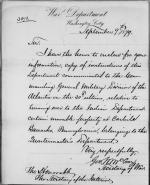
Adjutant General E. D. Townsend informs the Commanding General of the Atlantic that the Secretary of War George W. McCrary has ordered that all "movable property" at the Carlisle Barracks be turned over to the Indian Bureau as part of the transfer of the Barracks from the War to Interior Department. McCray encloses the letter to the Secretary…
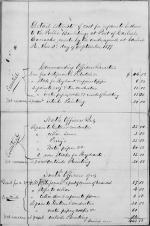
Richard H. Pratt forwards an estimate of cost for necessary repairs to the buildings at the Carlisle Barracks. These repairs, which are needed to prepare the buildings for use by the Carlisle Indian School, are estimated to cost $1,399.00.
Note: This item was copied from U.S. National Archives microfilm reels (M234), which were filmed…
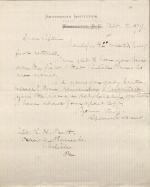
Spencer Fullerton Baird of the Smithsonian Institute writes to Richard Henry Pratt thanking him for his previous correspondence, and congratulating him on his securing of Carlisle Barracks for the purpose of establishing a school.
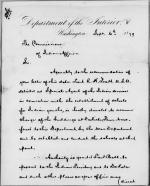
Acting Secretary of the Interior A. Bell informs the Commissioner of Indian Affairs that the War Department has transferred the buildings at the Carlisle Barracks to the Interior Department and that Special Agent Richard Henry Pratt is authorized to create an Indian school at the Barracks using the buildings. He also grants authority for Pratt…
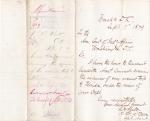
Letter from Richard Henry Pratt to the Commissioner of Indian Affairs, transferring his account of travel expenses from Florida. Immediately before this time, Pratt had been sent to Florida to locate, enumerate, and report on the condition of the Native Americans there.
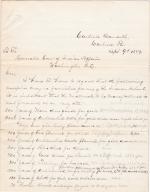
List of supplies requested by Richard Henry Pratt for the school he is preparing to establish at Carlisle Barracks. Requested supplies include clothing, fabric, sewing supplies, tableware, cooking supplies, and firefighting equipment.
Pratt refers to this request list in a letter sent to the Commissioner of Indian Affairs the following…
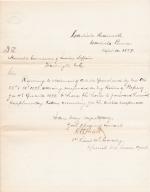
Richard Henry Pratt forwards his Supplementary Property Return forms to the Commissioner of Indian Affairs.
